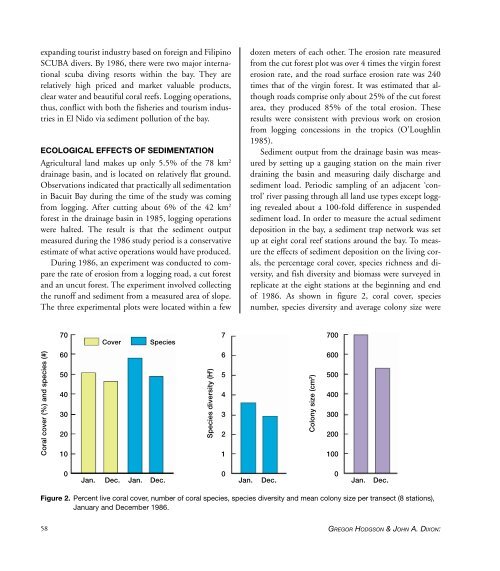Create successful ePaper yourself
Turn your PDF publications into a flip-book with our unique Google optimized e-Paper software.
expanding tourist industry based on foreign and Filipino<br />
SCUBA divers. By 1986, there were two major international<br />
scuba diving resorts within the bay. They are<br />
relatively high priced and market valuable products,<br />
clear water and beautiful coral reefs. Logging operations,<br />
thus, conflict with both the fisheries and tourism industries<br />
in El Nido via sediment pollution <strong>of</strong> the bay.<br />
ECOLOGICAL EFFECTS OF SEDIMENTATION<br />
Agricultural land makes up only 5.5% <strong>of</strong> the 78 km 2<br />
drainage basin, and is located on relatively flat ground.<br />
Observations indicated that practically all sedimentation<br />
in Bacuit Bay during the time <strong>of</strong> the study was coming<br />
from logging. After cutting about 6% <strong>of</strong> the 42 km 2<br />
forest in the drainage basin in 1985, logging operations<br />
were halted. The result is that the sediment output<br />
measured during the 1986 study period is a conservative<br />
estimate <strong>of</strong> what active operations would have produced.<br />
During 1986, an experiment was conducted to compare<br />
the rate <strong>of</strong> erosion from a logging road, a cut forest<br />
and an uncut forest. The experiment involved collecting<br />
the run<strong>of</strong>f and sediment from a measured area <strong>of</strong> slope.<br />
The three experimental plots were located within a few<br />
dozen meters <strong>of</strong> each other. The erosion rate measured<br />
from the cut forest plot was over 4 times the virgin forest<br />
erosion rate, and the road surface erosion rate was 240<br />
times that <strong>of</strong> the virgin forest. It was estimated that although<br />
roads comprise only about 25% <strong>of</strong> the cut forest<br />
area, they produced 85% <strong>of</strong> the total erosion. These<br />
results were consistent with previous work on erosion<br />
from logging concessions in the tropics (O’Loughlin<br />
1985).<br />
Sediment output from the drainage basin was measured<br />
by setting up a gauging station on the main river<br />
draining the basin and measuring daily discharge and<br />
sediment load. Periodic sampling <strong>of</strong> an adjacent ‘control’<br />
river passing through all land use types except logging<br />
revealed about a 100-fold difference in suspended<br />
sediment load. In order to measure the actual sediment<br />
deposition in the bay, a sediment trap network was set<br />
up at eight coral reef stations around the bay. To measure<br />
the effects <strong>of</strong> sediment deposition on the living corals,<br />
the percentage coral cover, species richness and diversity,<br />
and fish diversity and biomass were surveyed in<br />
replicate at the eight stations at the beginning and end<br />
<strong>of</strong> 1986. As shown in figure 2, coral cover, species<br />
number, species diversity and average colony size were<br />
70<br />
Cover<br />
Species<br />
7<br />
700<br />
<strong>Coral</strong> cover (%) and species (#)<br />
60<br />
50<br />
40<br />
30<br />
20<br />
10<br />
Species diversity (H I )<br />
6<br />
5<br />
4<br />
3<br />
2<br />
1<br />
Colony size (cm 2 )<br />
600<br />
500<br />
400<br />
300<br />
200<br />
100<br />
0<br />
Jan. Dec. Jan. Dec.<br />
0<br />
0<br />
Jan. Dec. Jan. Dec.<br />
Figure 2. Percent live coral cover, number <strong>of</strong> coral species, species diversity and mean colony size per transect (8 stations),<br />
January and December 1986.<br />
58<br />
GREGOR HODGSON & JOHN A. DIXON:


















